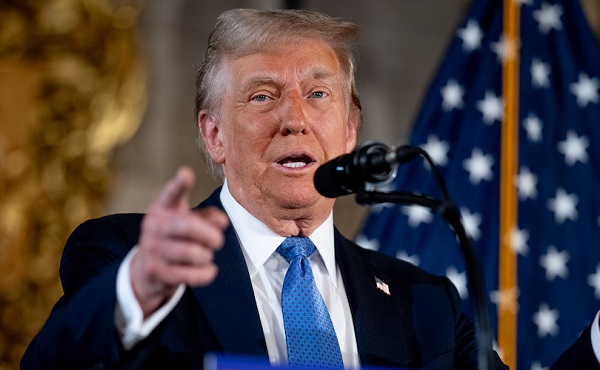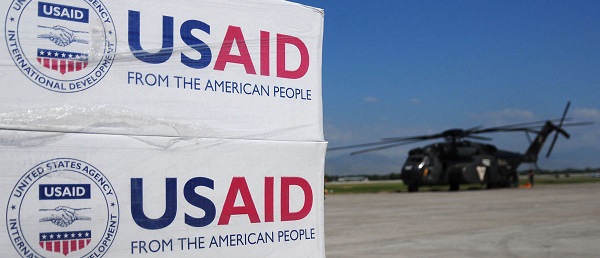Brownstone Institute
These Amendments Would Open the Door to a Dangerous Global Health Bureaucracy

From the Brownstone Institute
BY
One of the most extraordinary and disturbing aspects of the proposed amendments to IHR is the removal of an important clause requiring that the implementation of the regulations be “with full respect for the dignity, human rights and fundamental freedoms of persons.”
In its place, the new clause reads that the implementation of the regulations shall be “based on the principles of equity, inclusivity, coherence and in accordance with their (the?) common but differentiated responsibilities of the States Parties, taking into consideration their social and economic development.” It is hard to know how any sane and responsible adult could justify removing “dignity, human rights, and fundamental freedoms” from International Health Regulations.
The Covid pandemic gave the World Health Organization and its partners unprecedented visibility and a tremendous amount of “soft” power to shape public health law and policies across the world. Over the past year or so, the WHO has been pushing hard to consolidate and expand its power to declare and manage public health emergencies on a global scale.
The primary instruments for this consolidation are a WHO Pandemic Accord and a series of far-reaching amendments to existing International Health Regulations (IHR). The target date for finalizing both the IHR Amendments and the new Pandemic Accord is May 2024.
The net effect of the proposed text for the pandemic accord and the proposed amendments to the International Health Regulations, would be to create a legal and financial basis for the emergence of an elaborate, internationally coordinated bio-surveillance regime and significantly strengthen the authority of the World Health Organization to direct and coordinate the international response to global and regional public health threats.
It is not entirely clear why the WHO decided to negotiate a separate pandemic treaty that overlaps in significant ways with the proposed IHR amendments. In any case, most of the far-reaching changes to global health regulations are already contained within the IHR amendments, so that is what we will focus on here.
Even if the WHO failed to get a new pandemic treaty passed, the proposed amendments to International Health Regulations would be sufficient by themselves to confer unprecedented power on the WHO to direct international health and vaccination policies in circumstances deemed by the WHO to be a “public health emergency of international concern.”
The WHO wants the IHR amendments to be finalized on time for next year’s World Health Assembly, scheduled for 27 May – 1 June 2024. Assuming the amendments are approved by a simple majority of the delegates, they will be considered fully ratified 12 months after that, unless heads of State formally reject them within the designated opt-out period, which has been reduced from 18 to 10 months.
If ratified, they will come into effect two years after their announcement at the May 2024 World Health Assembly (i.e., around June 2026), as stipulated in the annex to Amendments to the International Health Regulations (2005) agreed to on 28th May 2022.
In other words, revisions to the International Health Regulations will pass by default rather than by formal acceptance by heads of State. The silence of heads of State will be construed as consent. This makes it all the easier for the revised IHR to pass without proper legislative scrutiny and without a public debate in the States that are subject to the new legal framework.
To get a flavour of how these changes in international law are likely to impact the policies of governments and citizens’ lives more broadly, it is sufficient to review a selection of the proposed amendments. While we do not know which of the amendments will survive the negotiation process, the direction of travel is alarming.
Taken together, these amendments to International Health Regulations would push us in the direction of a global public health bureaucracy with limited democratic accountability, glaring conflicts of interest, and significant potential for systematic harm to the health and liberties of citizens.
The amendments discussed below are drawn from a 46-page document hosted on the WHO webpage entitled “Article-by-Article Compilation of Proposed Amendments to the International Health Regulations (2005) submitted in accordance with decision WHA75(9) (2022).” Because these changes are being negotiated largely outside the frame of national electoral politics, the average citizens is barely aware of them.
Should these amendments come into force, States will be bound by international law, in the event of a public health emergency (as defined by WHO) to follow the playbook of health policies determined by the WHO and its “emergency committee” of “experts,” leaving far less scope for national parliaments and governments to set policies that diverge from WHO recommendations.
Insofar as national States formally consent to the IHR amendments, their sovereignty would remain intact, from a legal perspective. But insofar as they are binding themselves to dance to the tune of political actors outside the scope of national politics, they would clearly lose their freedom to set their own policies in this domain, and health policy “gurus,” instead of representing their fellow citizens, would represent a global health regime transcending national politics and operating above national law.
Under a globally coordinated public health regime, activated by an international public health emergency declared by the WHO, citizens would be vulnerable to errors committed by WHO-nominated “experts” sitting in Geneva or New York, errors which could replicate themselves through a global health system with little resistance from national governments.
Citizens have a right to know that the amended regulations as they stand would give unprecedented power to a WHO-led global health regime and, by implication, its most influential financial and political stakeholders like the World Economic Forum, the World Bank, and the Bill & Melinda Gates Foundation, all of which are largely beyond the reach of national voters and legislators.
There are dozens of proposed amendments to the 2005 International Health Regulations. Here, I will highlight eight changes that are of special concern because of their implications for the independence of national health regimes and for the rights of citizens:
States Bind Themselves to Follow WHO’s Advice as “The Guidance and Coordinating Authority” During an International Public Health Emergency
One of the amendments to IHR (International Health Regulations) reads, “States Parties recognize WHO as the guidance and coordinating authority of international public health response during public health Emergency of International Concern and undertake to follow WHO’s recommendations in their international public health responses.” Like many other treaty “undertakings,” the means for other parties to IHR to enforce this “undertaking” are limited.
Nevertheless, States party to the new regulations would be legally binding themselves to adhere to WHO recommendations and may lose credibility or suffer politically for failing to follow through on their international treaty commitments. This may seem “toothless” to some, but the reality is that this sort of “soft power” is what drives a good deal of compliance with international law.
Removal of “Non-Binding” Language
In the previous version of Article 1, WHO “recommendations” were defined as “non-binding advice.” In the new version, they are defined simply as “advice.” The only reasonable interpretation of this change is that the author wished to remove the impression that States were at liberty to disregard WHO recommendations. Insofar as signatories do “undertake to follow WHO’s recommendations in their international public health responses,” it would indeed appear that such “advice” becomes legally “binding” under the new regulations, making it legally difficult for States to dissent from WHO recommendations.
Removal of Reference to “Dignity, Human Rights and Fundamental Freedoms”
One of the most extraordinary and disturbing aspects of the proposed amendments to IHR is the removal of an important clause requiring that the implementation of the regulations be “with full respect for the dignity, human rights and fundamental freedoms of persons.”
In its place, the new clause reads that the implementation of the regulations shall be “based on the principles of equity, inclusivity, coherence and in accordance with their (the?) common but differentiated responsibilities of the States Parties, taking into consideration their social and economic development.” It is hard to know how any sane and responsible adult could justify removing “dignity, human rights, and fundamental freedoms” from International Health Regulations.
Expansion of Scope of International Health Regulations
In the revised version of Article 2, the scope of IHR includes not only public health risks, but “all risks with a potential to impact public health.” Under this amendment, International Health Regulations, and their main coordinating body, the WHO, would be concerned not only with public health risks, but with every conceivable societal risk that might “impact” public health. Workplace stress? Vaccine hesitancy? Disinformation? Misinformation? Availability of pharmaceutical products? Low GDP? The basis for WHO intervention and guidance could be expanded indefinitely.
Consolidation of a Global Health Bureaucracy
Each State should nominate a “National IHR Focal Point” for “the implementation of health measures under these regulations.” These “focal points” could avail of WHO “capacity building” and “technical assistance.” IHR Focal Points, presumably manned by unelected bureaucrats and “experts,” would be essentially nodes in a new WHO-led global health bureaucracy.
Other important aspects of this new global health bureaucracy would be the WHO’s role in developing global “allocation plans for health products” (including vaccines), the WHO’s role as an information hub for expanded disease surveillance and research units across the world, and the WHO’s role as a a lead player in an international network of actors devoted to combatting “false and unreliable information” about public health events and anti-epidemic measures.
Expansion of WHO Emergency Powers
Under the revised regulations, the Director-General of the World Health Organization, “based on the opinion/advice of the Emergency Committee,” may designate an event as “having the potential to develop into a public health emergency of international concern, (and) communicate this and the recommended measures to State parties…” The introduction of the concept of a “potential” public health emergency, along with the idea of an “intermediate” emergency, also to be found among the proposed amendments, gives the WHO much wider leeway to set in motion emergency protocols and recommendations. For who knows what a “potential” or “intermediate” emergency amounts to?
Entrenchment and Legitimation of an International Bio-Surveillance Regime
The old Article 23, “Health Measures on arrival and departure,” authorizes States to require that travellers produce certain medical credentials prior to travel, including “a non-invasive medical examination which is the least intrusive examination that could achieve the public health objective.” In the new version of Article 23, travellers may be required to produce “documents containing information…on a laboratory test for a pathogen and/or information on vaccination against a disease.”
These documents may include WHO-validated digital health certificates. Essentially, this reaffirms and legally validates the vaccine passport regime that imposed prohibitive testing costs on unvaccinated citizens in 2021-23, and resulted in thousands and probably tens of thousands of people vaccinating just for the convenience of travelling, rather than based on health considerations.
Global Initiatives for Combating “False and Unreliable Information”
Both WHO and States bound by IHR, under the revised draft of IHR, “shall collaborate” in “countering the dissemination of false and unreliable information about public health events, preventive and anti-epidemic measures and activities in the media, social networks, and other ways of disseminating such information.” Clearly the misinformation/disinformation amendments entail a propaganda and censorship regime.
There is no other plausible way to interpret “countering the dissemination of false and unreliable information,” and this is exactly how anti-disinformation measures have been interpreted since the Covid pandemic was announced in 2020 – measures, it may be added, that suppressed sound scientific contributions concerning vaccine risks, lab origins of the novel coronavirus, and efficacy of community masking.
The joint effect of these and other proposed changes to International Health Regulations would be to enthrone the WHO and its director-general at the head of an elaborate global health bureaucracy beholden to the special interests of WHO patrons, a bureaucracy that would be operated largely with the cooperation of State officials and agencies implementing “advice” and “recommendations” issued by the WHO, which State parties have legally undertaken to follow.
While it is true that international treaties cannot be coercively enforced, this does not mean that international law is inconsequential. Under the newly amended regulations, a highly centralized public health bureaucracy would be propped up by lavish funding mechanisms and protected by international law. A bureaucracy of this sort would inevitably become entrenched and intertwined with national bureaucracies, and would become an important element of the policymaking architecture of pandemic planning and responses.
Though national States could, theoretically, bypass this bureaucracy and renege on their legal undertakings under IHR, taking a different path to that recommended by WHO, this would be rather strange, given that they themselves would have both approved and financed the regime they are boycotting.
In the face of opposition from one or more signatory States, the WHO and its partners could pressure such a State into complying with its edicts by shaming it into upholding its legal commitments, or else other States may reprimand “renegade” states for putting international health in jeopardy, and apply political, financial and diplomatic pressure to secure compliance. Thus, while IHR would operate upon State officials in a softer way than national, police-backed regulations, it would certainly not be powerless or politically inconsequential.
The impact of the new global health bureaucracy on the lives of ordinary citizens may be quite dramatic: it would erect a global censorship regime legitimated by international law, making challenges to officially sanctioned information harder than ever; and it would make international public health responses even more slavishly dependent on WHO directives than they were before, discouraging independent, dissenting responses such as that of Sweden during the Covid pandemic.
Last but not least, the new global health bureaucracy would put the fate of ordinary citizens – our national and international mobility, our right to informed consent to medication, our bodily integrity, and ultimately, our health – in the hands of public health officials acting in lockstep with WHO “recommendations.”
Apart from the fact that policy diversification and experimentation is essential to a robust healthcare system, and is crushed by a highly centralized response to health emergencies, the WHO is already riddled with internal conflicts of interest and a track record of catastrophically unsound judgments, making them singularly unqualified to reliably identify a global health emergency or coordinate the response to it.
To start with, the WHO’s income stream depends on individuals like Bill Gates who have significant financial stakes in the pharmaceutical industry. How can we possibly expect the WHO to make impartial, disinterested recommendations about, say, the safety and efficacy of vaccines, when its own donors are financially invested in the success of specific pharmaceutical products, including vaccines?
Secondly, to allow the WHO to declare an international public health emergency is to create an obvious perverse incentive: given that a large part of the raison d’être of a WHO-led global health bureaucracy is to prevent, monitor, and respond to public health emergencies, and the activation of the WHO’s emergency powers depends on the presence of an actual or potential “public health emergency of international concern,” the WHO’s Director-General has an obvious professional and institutional interest in declaring potential or actual public health emergencies.
Third, the WHO wasted no time in praising China’s brutal and ultimately unsuccessful lockdowns, continues to support the censorship of their critics, repeatedly recommended community masking in the absence of plausible evidence of efficacy, failed to warn the public in a timely manner about the serious risks of mRNA vaccines, and has entered into a partnership with the European Union to extend the discriminatory and coercive Covid vaccine certificate system globally. These are certainly not people I would trust as custodians of my bodily integrity, health, informed consent, or mobility.
Republished from the author’s Substack
Brownstone Institute
Net Zero: The Mystery of the Falling Fertility

From the Brownstone Institute
By
If you want to argue that a mysterious factor X is responsible for the drop in fertility, you will have to explain (1) why the factor affected only the vaccinated, and (2) why it started affecting them at about the time of vaccination.
In January 2022, the number of children born in the Czech Republic suddenly decreased by about 10%. By the end of 2022, it had become clear that this was a signal: All the monthly numbers of newborns were mysteriously low.
In April 2023, I wrote a piece for a Czech investigative platform InFakta and suggested that this unexpected phenomenon might be connected to the aggressive vaccination campaign that had started approximately 9 months before the drop in natality. Denik N – a Czech equivalent of the New York Times – immediately came forward with a “devastating takedown” of my article, labeled me a liar and claimed that the pattern can be explained by demographics: There were fewer women in the population and they were getting older.
To compare fertility across countries (and time), the so-called Total Fertility Rate (TFR) is used. Roughly speaking, it is the average number of children that are born to a woman over her lifetime. TFR is independent of the number of women and of their age structure. Figure 1 below shows the evolution of TFR in several European countries between 2001 and 2023. I selected countries that experienced a similar drop in TFR in 2022 as the Czech Republic.

So, by the end of 2023, the following two points were clear:
- The drop in natality in the Czech Republic in 2022 could not be explained by demographic factors. Total fertility rate – which is independent of the number of women and their age structure – dropped sharply in 2022 and has been decreasing ever since. The data for 2024 show that the Czech TFR has decreased further to 1.37.
- Many other European countries experienced the same dramatic and unexpected decrease in fertility that started at the beginning of 2022. I have selected some of them for Figure 1 but there are more: The Netherlands, Norway, Slovakia, Slovenia, and Sweden. On the other hand, there are some countries that do not show a sudden drop in TFR, but rather a steady decline over a longer period (e.g. Belgium, France, UK, Greece, or Italy). Notable exceptions are Bulgaria, Spain, and Portugal where fertility has increased (albeit from very low numbers). The Human Fertility Project database has all the numbers.
This data pattern is so amazing and unexpected that even the mainstream media in Europe cannot avoid the problem completely. From time to time, talking heads with many academic titles appear and push one of the politically correct narratives: It’s Putin! (Spoiler alert: The war started in February 2022; however, children not born in 2022 were not conceived in 2021). It’s the inflation caused by Putin! (Sorry, that was even later). It’s the demographics! (Nope, see above, TFR is independent of the demographics).
Thus, the “v” word keeps creeping back into people’s minds and the Web’s Wild West is ripe with speculation. We decided not to speculate but to wrestle some more data from the Czech government. For many months, we were trying to acquire the number of newborns in each month, broken down by age and vaccination status of the mother. The post-socialist health-care system of our country is a double-edged sword: On one hand, the state collects much more data about citizens than an American would believe. On the other hand, we have an equivalent of the FOIA, and we are not afraid to use it. After many months of fruitless correspondence with the authorities, we turned to Jitka Chalankova – a Czech Ron Johnson in skirts – who finally managed to obtain an invaluable data sheet.
To my knowledge, the datasheet (now publicly available with an English translation here) is the only officially released dataset containing a breakdown of newborns by the Covid-19 vaccination status of the mother. We requested much more detailed data, but this is all we got. The data contains the number of births per month between January 2021 and December 2023 given by women (aged 18-39) who were vaccinated, i.e., had received at least one Covid vaccine dose by the date of delivery, and by women who were unvaccinated, i.e., had not received any dose of any Covid vaccine by the date of delivery.
Furthermore, the numbers of births per month by women vaccinated by one or more doses during pregnancy were provided. This enabled us to estimate the number of women who were vaccinated before conception. Then, we used open data on the Czech population structure by age, and open data on Covid vaccination by day, sex, and age.
Combining these three datasets, we were able to estimate the rates of successful conceptions (i.e., conceptions that led to births nine months later) by preconception vaccination status of the mother. Those interested in the technical details of the procedure may read Methods in the newly released paper. It is worth mentioning that the paper had been rejected without review in six high-ranking scientific journals. In Figure 2, we reprint the main finding of our analysis.

Figure 2 reveals several interesting patterns that I list here in order of importance:
- Vaccinated women conceived about a third fewer children than would be expected from their share of the population. Unvaccinated women conceived at about the same rate as all women before the pandemic. Thus, a strong association between Covid vaccination status and successful conceptions has been established.
- In the second half of 2021, there was a peak in the rate of conceptions of the unvaccinated (and a corresponding trough in the vaccinated). This points to rather intelligent behavior of Czech women, who – contrary to the official advice – probably avoided vaccination if they wanted to get pregnant. This concentrated the pregnancies in the unvaccinated group and produced the peak.
- In the first half of 2021, there was significant uncertainty in the estimates of the conception rates. The lower estimate of the conception rate in the vaccinated was produced by assuming that all women vaccinated (by at least one dose) during pregnancy were unvaccinated before conception. This was almost certainly true in the first half of 2021 because the vaccines were not available prior to 2021. The upper estimate was produced by assuming that all women vaccinated (by at least one dose) during pregnancy also received at least one dose before conception. This was probably closer to the truth in the second part of 2021. Thus, we think that the true conception rates for the vaccinated start close to the lower bound in early 2021 and end close to the upper bound in early 2022. Once again, we would like to be much more precise, but we have to work with what we have got.
Now that the association between Covid-19 vaccination and lower rates of conception has been established, the one important question looms: Is this association causal? In other words, did the Covid-19 vaccines really prevent women from getting pregnant?
The guardians of the official narrative brush off our findings and say that the difference is easily explained by confounding: The vaccinated tend to be older, more educated, city-dwelling, more climate change aware…you name it. That all may well be true, but in early 2022, the TFR of the whole population dropped sharply and has been decreasing ever since.
So, something must have happened in the spring of 2021. Had the population of women just spontaneously separated into two groups – rednecks who wanted kids and didn’t want the jab, and city slickers who didn’t want kids and wanted the jab – the fertility rate of the unvaccinated would indeed be much higher than that of the vaccinated. In that respect, such a selection bias could explain the observed pattern. However, had this been true, the total TFR of the whole population would have remained constant.
But this is not what happened. For some reason, the TFR of the whole population jumped down in January 2022 and has been decreasing ever since. And we have just shown that, for some reason, this decrease in fertility affected only the vaccinated. So, if you want to argue that a mysterious factor X is responsible for the drop in fertility, you will have to explain (1) why the factor affected only the vaccinated, and (2) why it started affecting them at about the time of vaccination. That is a tall order. Mr. Occam and I both think that X = the vaccine is the simplest explanation.
What really puzzles me is the continuation of the trend. If the vaccines really prevented conception, shouldn’t the effect have been transient? It’s been more than three years since the mass vaccination event, but fertility rates still keep falling. If this trend continues for another five years, we may as well stop arguing about pensions, defense spending, healthcare reform, and education – because we are done.
We are in the middle of what may be the biggest fertility crisis in the history of mankind. The reason for the collapse in fertility is not known. The governments of many European countries have the data that would unlock the mystery. Yet, it seems that no one wants to know.
Author
Brownstone Institute
FDA Exposed: Hundreds of Drugs Approved without Proof They Work

From the Brownstone Institute
By
The US Food and Drug Administration (FDA) has approved hundreds of drugs without proof that they work—and in some cases, despite evidence that they cause harm.
That’s the finding of a blistering two-year investigation by medical journalists Jeanne Lenzer and Shannon Brownlee, published by The Lever.
Reviewing more than 400 drug approvals between 2013 and 2022, the authors found the agency repeatedly ignored its own scientific standards.
One expert put it bluntly—the FDA’s threshold for evidence “can’t go any lower because it’s already in the dirt.”
A System Built on Weak Evidence
The findings were damning—73% of drugs approved by the FDA during the study period failed to meet all four basic criteria for demonstrating “substantial evidence” of effectiveness.
Those four criteria—presence of a control group, replication in two well-conducted trials, blinding of participants and investigators, and the use of clinical endpoints like symptom relief or extended survival—are supposed to be the bedrock of drug evaluation.
Yet only 28% of drugs met all four criteria—40 drugs met none.
These aren’t obscure technicalities—they are the most basic safeguards to protect patients from ineffective or dangerous treatments.
But under political and industry pressure, the FDA has increasingly abandoned them in favour of speed and so-called “regulatory flexibility.”
Since the early 1990s, the agency has relied heavily on expedited pathways that fast-track drugs to market.
In theory, this balances urgency with scientific rigour. In practice, it has flipped the process. Companies can now get drugs approved before proving that they work, with the promise of follow-up trials later.
But, as Lenzer and Brownlee revealed, “Nearly half of the required follow-up studies are never completed—and those that are often fail to show the drugs work, even while they remain on the market.”
“This represents a seismic shift in FDA regulation that has been quietly accomplished with virtually no awareness by doctors or the public,” they added.
More than half the approvals examined relied on preliminary data—not solid evidence that patients lived longer, felt better, or functioned more effectively.
And even when follow-up studies are conducted, many rely on the same flawed surrogate measures rather than hard clinical outcomes.
The result: a regulatory system where the FDA no longer acts as a gatekeeper—but as a passive observer.
Cancer Drugs: High Stakes, Low Standards
Nowhere is this failure more visible than in oncology.
Only 3 out of 123 cancer drugs approved between 2013 and 2022 met all four of the FDA’s basic scientific standards.
Most—81%—were approved based on surrogate endpoints like tumour shrinkage, without any evidence that they improved survival or quality of life.
Take Copiktra, for example—a drug approved in 2018 for blood cancers. The FDA gave it the green light based on improved “progression-free survival,” a measure of how long a tumour stays stable.
But a review of post-marketing data showed that patients taking Copiktra died 11 months earlier than those on a comparator drug.
It took six years after those studies showed the drug reduced patients’ survival for the FDA to warn the public that Copiktra should not be used as a first- or second-line treatment for certain types of leukaemia and lymphoma, citing “an increased risk of treatment-related mortality.”
Elmiron: Ineffective, Dangerous—And Still on the Market
Another striking case is Elmiron, approved in 1996 for interstitial cystitis—a painful bladder condition.
The FDA authorized it based on “close to zero data,” on the condition that the company conduct a follow-up study to determine whether it actually worked.
That study wasn’t completed for 18 years—and when it was, it showed Elmiron was no better than placebo.
In the meantime, hundreds of patients suffered vision loss or blindness. Others were hospitalized with colitis. Some died.
Yet Elmiron is still on the market today. Doctors continue to prescribe it.
“Hundreds of thousands of patients have been exposed to the drug, and the American Urological Association lists it as the only FDA-approved medication for interstitial cystitis,” Lenzer and Brownlee reported.
“Dangling Approvals” and Regulatory Paralysis
The FDA even has a term—”dangling approvals”—for drugs that remain on the market despite failed or missing follow-up trials.
One notorious case is Avastin, approved in 2008 for metastatic breast cancer.
It was fast-tracked, again, based on ‘progression-free survival.’ But after five clinical trials showed no improvement in overall survival—and raised serious safety concerns—the FDA moved to revoke its approval for metastatic breast cancer.
The backlash was intense.
Drug companies and patient advocacy groups launched a campaign to keep Avastin on the market. FDA staff received violent threats. Police were posted outside the agency’s building.
The fallout was so severe that for more than two decades afterwards, the FDA did not initiate another involuntary drug withdrawal in the face of industry opposition.
Billions Wasted, Thousands Harmed
Between 2018 and 2021, US taxpayers—through Medicare and Medicaid—paid $18 billion for drugs approved under the condition that follow-up studies would be conducted. Many never were.
The cost in lives is even higher.
A 2015 study found that 86% of cancer drugs approved between 2008 and 2012 based on surrogate outcomes showed no evidence that they helped patients live longer.
An estimated 128,000 Americans die each year from the effects of properly prescribed medications—excluding opioid overdoses. That’s more than all deaths from illegal drugs combined.
A 2024 analysis by Danish physician Peter Gøtzsche found that adverse effects from prescription medicines now rank among the top three causes of death globally.
Doctors Misled by the Drug Labels
Despite the scale of the problem, most patients—and most doctors—have no idea.
A 2016 survey published in JAMA asked practising physicians a simple question—what does FDA approval actually mean?
Only 6% got it right.
The rest assumed that it meant the drug had shown clear, clinically meaningful benefits—such as helping patients live longer or feel better—and that the data was statistically sound.
But the FDA requires none of that.
Drugs can be approved based on a single small study, a surrogate endpoint, or marginal statistical findings. Labels are often based on limited data, yet many doctors take them at face value.
Harvard researcher Aaron Kesselheim, who led the survey, said the results were “disappointing, but not entirely surprising,” noting that few doctors are taught about how the FDA’s regulatory process actually works.
Instead, physicians often rely on labels, marketing, or assumptions—believing that if the FDA has authorized a drug, it must be both safe and effective.
But as The Lever investigation shows, that is not a safe assumption.
And without that knowledge, even well-meaning physicians may prescribe drugs that do little good—and cause real harm.
Who Is the FDA Working for?
In interviews with more than 100 experts, patients, and former regulators, Lenzer and Brownlee found widespread concern that the FDA has lost its way.
Many pointed to the agency’s dependence on industry money. A BMJ investigation in 2022 found that user fees now fund two-thirds of the FDA’s drug review budget—raising serious questions about independence.

Yale physician and regulatory expert Reshma Ramachandran said the system is in urgent need of reform.
“We need an agency that’s independent from the industry it regulates and that uses high-quality science to assess the safety and efficacy of new drugs,” she told The Lever. “Without that, we might as well go back to the days of snake oil and patent medicines.”
For now, patients remain unwitting participants in a vast, unspoken experiment—taking drugs that may never have been properly tested, trusting a regulator that too often fails to protect them.
And as Lenzer and Brownlee conclude, that trust is increasingly misplaced.
- Investigative report by Jeanne Lenzer and Shannon Brownlee at The Lever [link]
- Searchable public drug approval database [link]
- See my talk: Failure of Drug Regulation: Declining standards and institutional corruption
Republished from the author’s Substack
-

 International2 days ago
International2 days agoSecret Service suspends six agents nearly a year after Trump assassination attempt
-

 Bruce Dowbiggin1 day ago
Bruce Dowbiggin1 day agoThe Covid 19 Disaster: When Do We Get The Apologies?
-

 Crime22 hours ago
Crime22 hours agoSweeping Boston Indictment Points to Vast Chinese Narco-Smuggling and Illegal Alien Labor Plot via Mexican Border
-

 Alberta1 day ago
Alberta1 day agoAlberta school boards required to meet new standards for school library materials with regard to sexual content
-

 Automotive2 days ago
Automotive2 days agoAmerica’s EV Industry Must Now Compete On A Level Playing Field
-

 Environment23 hours ago
Environment23 hours agoEPA releases report on chemtrails, climate manipulation
-

 Business2 days ago
Business2 days ago‘Experts’ Warned Free Markets Would Ruin Argentina — Looks Like They Were Dead Wrong
-

 Business12 hours ago
Business12 hours agoTrump slaps Brazil with tariffs over social media censorship






